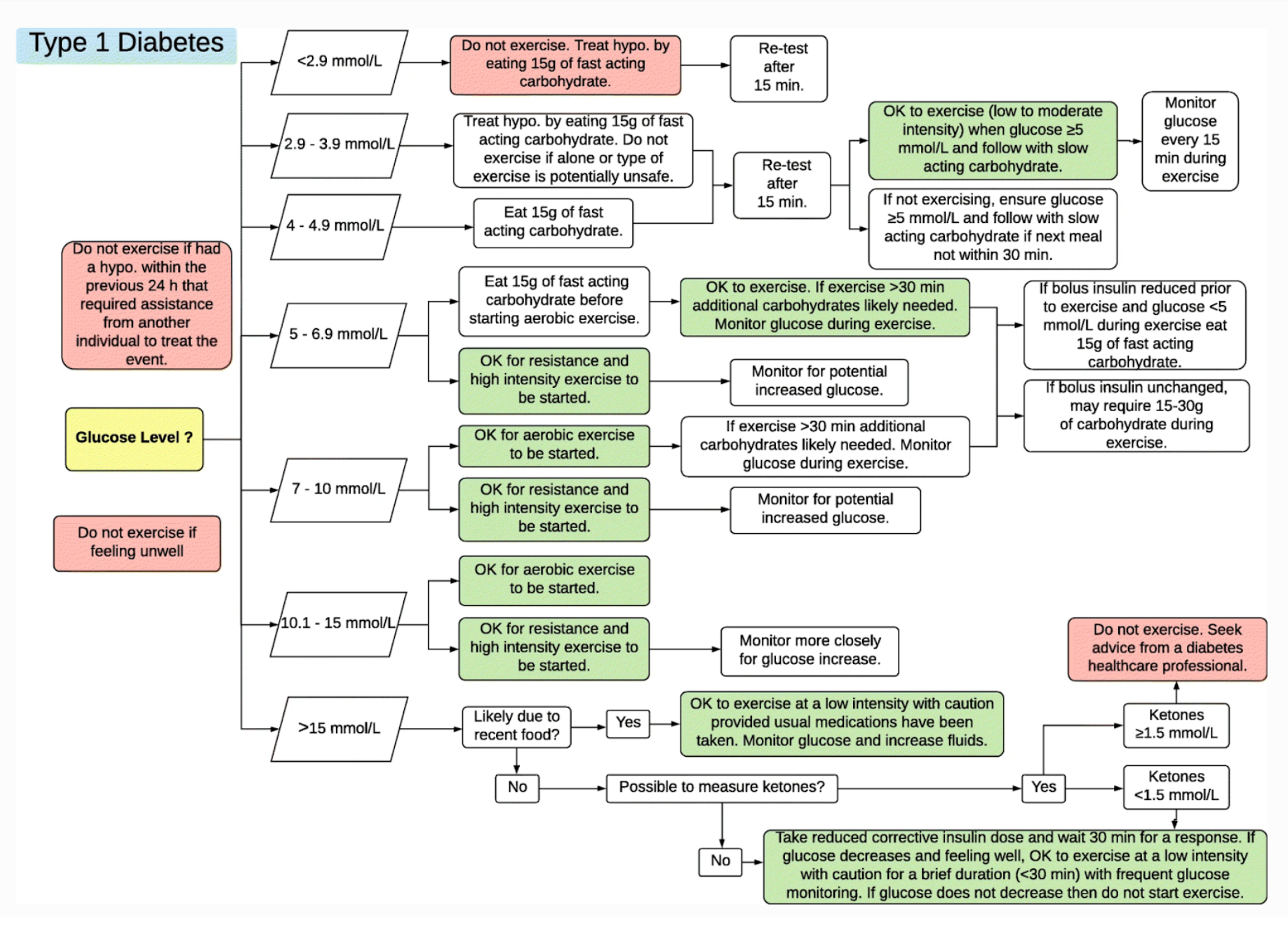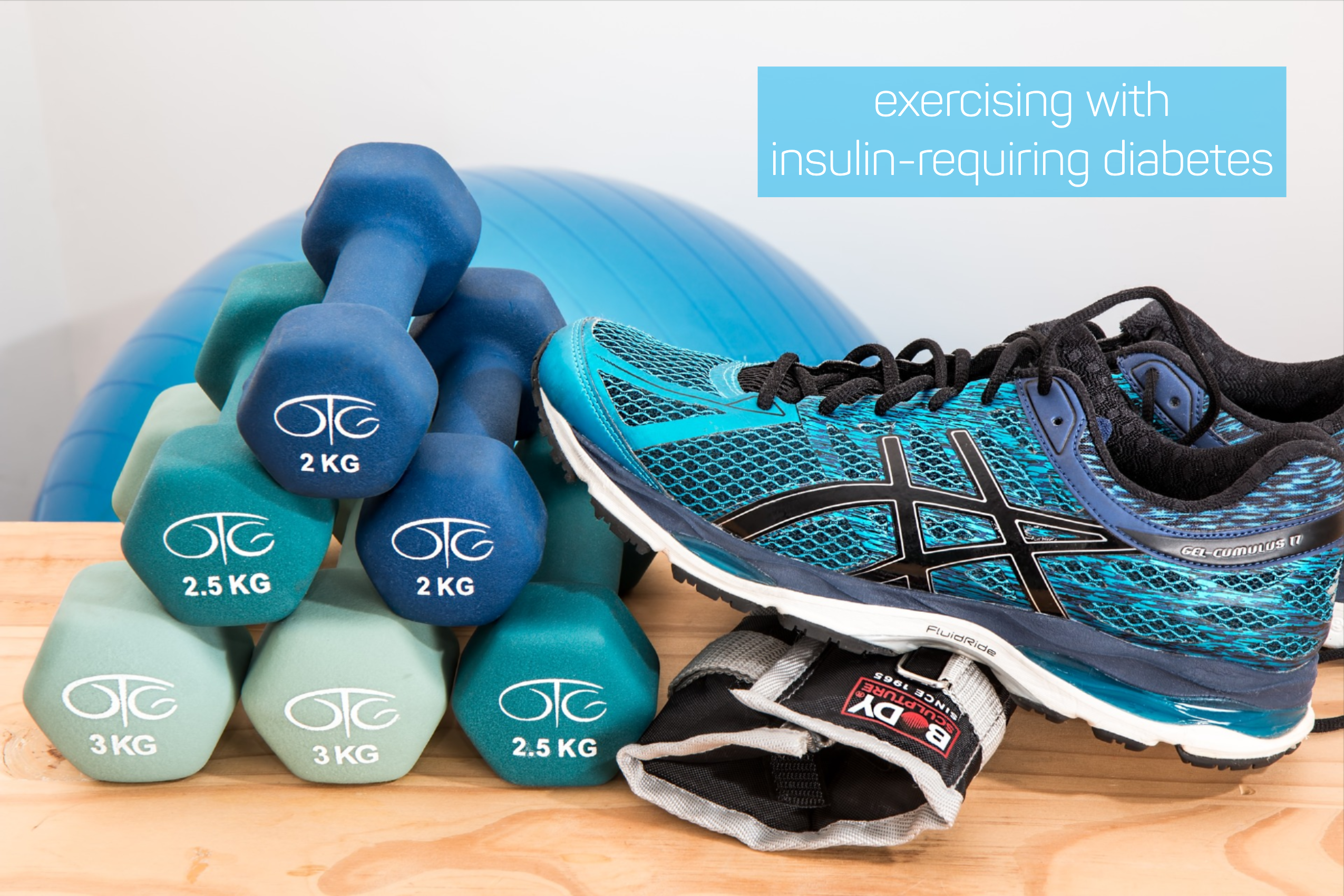Exercise is a cornerstone of diabetes management.1 At the beginning of each year, it shows up on a lot of New Year's resolutions lists—especially for people looking to reboot their health routines.
As with any aspirational goal, exercising regularly won’t just magically become part of your daily self-care routine. It takes consistent action to establish the exercise habit. And when you have to consider the effects of having insulin on-board, learning how to exercise safely becomes critically important.
Using insulin can add to the complexity of any decision. Exercise is no exception. In fact, when you have to take insulin into consideration, even the most elementary exercise decision becomes incredibly complex.
Consider the question “Should I exercise now?” With insulin in the mix, you really have to consider several questions. Is it safe for me to exercise right now? Are my glucose levels in a safe range? Is my glucose headed up or down? Am I at risk of going into hypoglycemia?
The process for answering “Should I?” can end up looking something like this:

Figure 1: Type 1 Decision Tree from Resources to Guide Exercise Specialists Managing Adults with Diabetes.2,3
It takes time and attention to get through this decision tree to your yes-or-no answer. When you get to the end you haven’t even put on your sneakers yet!
Learn about Exercise
Often when learning a new skill we turn to people with expertise to teach us. For exercise that could be a personal trainer. Where can you find a personal trainer who knows both exercise and diabetes?
I asked Christel Oerum, an ISSA-certified personal trainer with a specialization in Fitness and Diabetes. She’s the co-founder of DiabetesStrong,4 and person living with type 1 diabetes. Christel made it clear that this is a combination that is difficult to find.
“Most personal trainers (PT) know nothing about insulin-dependent diabetes, so you can’t expect them to support you when it comes to diabetes management and diabetes. Even if they do know a little about diabetes it’s very unlikely they know any details on how to manage insulin-dependent diabetes and exercise. You need to take charge and learn how to manage your diabetes when exercising.”
Learn How Exercise Affects Your Diabetes
For ideas on how to learn to manage your diabetes when exercising I turned to Ginger Vieira. She’s a former record-holding powerlifter, certified personal trainer, Ashtanga yoga instructor, and person living with type 1 diabetes. Ginger literally wrote the book on Your Diabetes Science Experiment.5 In it she lays out how to use testing-in-pairs to discover how exercise, food, medication, stress, etc. affect your personal glucose levels and what you can do about it.
When it comes to learning how exercise affects your diabetes Ginger suggests three steps.
First, “test your blood sugar before you start. Test it during [exercise] if you think you need to. And test it within 15 minutes of finishing. Take good notes on what happened. Did 30-minutes of cardio exercise before eating a meal drop your blood sugar? Yes or no? And then you can start to apply that logic to other types of exercise.
“Secondly, learn the difference between cardio/aerobic exercise vs. strength-training/anaerobic exercise because they impact your blood sugar very differently. The more you understand which type of exercise you’re doing, the better you can plan for your blood sugar needs around that exercise.
“Thirdly, when trying a new type of exercise, I always assume I could go low and I prepare for that potential. Fast-acting carbohydrates like gummy candy, glucose tabs, Smarties, juice, jelly beans—whatever is easiest for you to keep in your pocket or in your hand or within reach during your workout.”
Learn How Insulin Affects Your Exercise
Sheri Colberg, PhD explained to me the essential idea behind what you need to be aware of when it comes to insulin and exercise. Sheri is the founder of Diabetes Motion,6 a website providing resources to people with diabetes who want to be physically active. She is also a prolific author. Her book The Athlete's Guide to Diabetes is the go-to reference on how to approach managing diabetes while participating in over 150 individual sports.
“Be aware of how much insulin you have ‘on board’ during any activity as this can affect how your blood glucose responds. You will have to learn how to manage those levels (either by changing dosing for meals/snacks or for basal dosing) to keep your blood glucose in check during and after the activity. People on an insulin pump have an easier time in most cases changing their basal rates for activities as it can be done before, during, and after, whereas those on MDI have to think ahead if they want to change basal insulin.”
Ginger added the following:
“The easiest time of day to manage your blood sugar around exercise is before eating a meal, when it’s been at least three hours since your last bolus for food. By exercising before you eat, you don’t have to feed your exercise as much with carbohydrates because you don’t have active insulin in your bloodstream.
Sheri also recommends keeping an insulin pump connected during exercise. Also, minimize variables such as using temp basal rates and changing eating habits based on time of workouts to keep things simple.
A Few Other Things to Keep in Mind
What to look for in a personal trainer
It can still be helpful to work with a personal trainer even if you don’t have access to one with knowledge or training in diabetes. But what should you look for otherwise in a personal trainer?
Christel suggests that you “choose a PT that listens and understands your physical goals and can help you towards that. The PT needs to understand that if you need a break to deal with your blood sugars it’s not because you’re ‘lazy,’ it’s what you need to do to be safe.”
Being transparent about your diabetes is important to share. It’s a good idea to ensure that a personal trainer (or other people you are exercising with) know that you have diabetes and what to do in case of hypoglycemia
On staying motivated
Many exercise resolutions fall by the wayside after a few weeks. Keeping motivated is key to successfully adding exercise to your daily self-care and building up some good habits.
Ginger, when asked how she stays motivated to exercise, said, “I don’t let anything stop me from exercising daily because I know I feel AWESOME when my body gets regular exercise. In the coldest weeks of Vermont winter, I still put on my snowpants, boots, and hat and run through the snowy woods with my dogs every morning and every night. (Actually, I probably run faster at this time of year because it’s so damn cold!)”
Christel suggests the following: “I always recommend you find an activity you enjoy. Most things are going to be tough when you start out but if you after a month still hate doing a specific activity, then stop and find something else.
“A good way to find something you enjoy is to think back at what activities you enjoyed as a child and start doing that again.”
One of the things people often enjoyed as children is team or league sports. Sheri points out the bursty nature of team sports needs to be taken into consideration.
Sheri said, “The only hard thing about playing on a team or league is that you don't always know in advance how much you'll be playing, and both the duration of your play and its intensity can impact your blood glucose responses. Also, the timing of activity is often dictated by others and not of your own choosing.”
On avoiding burnout
Burnout can be another barrier to maintaining a daily exercise habit. Ginger has a compassionate take on how to manage this. She said, “I certainly have days where my blood sugars are tedious and interfering with my energy, but there’s one thing I never do that helps me prevent severe burnout: I never expect perfection. And on top of that, I forgive myself immediately when I make a decision or a mistake that leads to a super high blood sugar. Resilience -- brush off and try again.”
The Easiest Way to Start
A lot goes into exercising while using insulin. All the things you need to learn and manage can overwhelm even the most motivated person. Don’t let that stop you.
At the very least you can do this: Get up and go for a walk. Do it before eating. And, yes, you can start with short ones.
Footnotes:
1 https://www.diabeteshealth.com/exercise-recommendations-for-people-with-insulin-dependent-diabetes/
2 https://sportsmedicine-open.springeropen.com/articles/10.1186/s40798-019-0192-1/figures/4
3 https://sportsmedicine-open.springeropen.com/articles/10.1186/s40798-019-0192-1
5 https://www.amazon.com/Ginger-Vieira/e/B008ZPEGQ6?ref=sr_ntt_srch_lnk_1&qid=1573479757&sr=8-1


